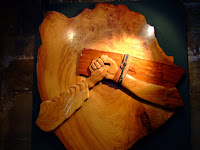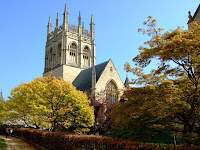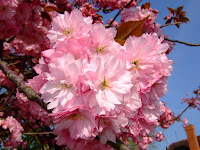 We started the day by driving back through Lincoln and heading for the Wolds. This is an area of attractive rolling countryside and we did a short walk between the villages of Tealby and Tealby Thorpe and back. Including the oldest thatched Pub in the county, Tealby has 22 listed buildings, including a school built by an uncle of Alfred Lord Tennyson. In this small village this means that one in every 8 buildings is listed.
We started the day by driving back through Lincoln and heading for the Wolds. This is an area of attractive rolling countryside and we did a short walk between the villages of Tealby and Tealby Thorpe and back. Including the oldest thatched Pub in the county, Tealby has 22 listed buildings, including a school built by an uncle of Alfred Lord Tennyson. In this small village this means that one in every 8 buildings is listed. A pleasant drive took us to Louth where Alfred Lord Tennyson went to school. It is a very lovely market town, with a stunning tall tower on the impressive church. It is quite a breathtaking vista as you round the corner on the road into town and see the church steeple dead ahead and framed by the buildings along the street. At 295 feet, it is the tallest Anglican parish church in the UK and, surprisingly, 25 feet taller than Lincoln Cathedral.
A pleasant drive took us to Louth where Alfred Lord Tennyson went to school. It is a very lovely market town, with a stunning tall tower on the impressive church. It is quite a breathtaking vista as you round the corner on the road into town and see the church steeple dead ahead and framed by the buildings along the street. At 295 feet, it is the tallest Anglican parish church in the UK and, surprisingly, 25 feet taller than Lincoln Cathedral. Alford was the next stop. This attractive town boasts a rare 5-sail windmill and the largest thatched manor house in England.
Alford was the next stop. This attractive town boasts a rare 5-sail windmill and the largest thatched manor house in England. Tattershall Castle is one of the many great finds in the middle of nowhere. Built in the 15th century, it has managed to survive thanks to the intervention of Lord Curzon who rescued and restored it early in the 20th century.
Tattershall Castle is one of the many great finds in the middle of nowhere. Built in the 15th century, it has managed to survive thanks to the intervention of Lord Curzon who rescued and restored it early in the 20th century.  As it was uninhabited from the middle ages, the castle has never been altered and modernised. Views from the top are stunning: the tower of Lincoln Cathedral to the northwest, and the Boston Stump to the southeast.
As it was uninhabited from the middle ages, the castle has never been altered and modernised. Views from the top are stunning: the tower of Lincoln Cathedral to the northwest, and the Boston Stump to the southeast. After lunch here, it was on to Boston. Here, in 1607 in the Guildhall the Pilgrim Fathers were imprisoned and tried for attempting illegal emigration. Later, they did sail for Holland and ultimately, in 1620, to “New England”.
After lunch here, it was on to Boston. Here, in 1607 in the Guildhall the Pilgrim Fathers were imprisoned and tried for attempting illegal emigration. Later, they did sail for Holland and ultimately, in 1620, to “New England”.North of Boston is the Sibsey Trader windmill. This stands six stories high and, when built, was the very latest in technology; the Rolls Royce of windmills, with its six sails.
 We were able to climb as high as the fifth floor, where we could observe the gears and machinery from behind the safety screens. They provide a teashop with cakes and bread baked from flour milled on the premises.
We were able to climb as high as the fifth floor, where we could observe the gears and machinery from behind the safety screens. They provide a teashop with cakes and bread baked from flour milled on the premises.Fortified by a sandwich made to order from their home baked bread,
 we set off to Spalding. The guidebook we consult 'Hidden Places of England' had a photo suggesting this area is full of fields of tulips. As tulips are in full bloom, we cruised the area known as South Holland, but although there are many fields of daffodils, tulips are now a thing of the past according to the information centre.
we set off to Spalding. The guidebook we consult 'Hidden Places of England' had a photo suggesting this area is full of fields of tulips. As tulips are in full bloom, we cruised the area known as South Holland, but although there are many fields of daffodils, tulips are now a thing of the past according to the information centre.Time for home, but as we happened to pass through Crowland
 we peered at the Abbey through the gate and were fascinated by the town’s Trinity Bridge over nothing. Once the place where a stream (long since dried up) divided, the bridge was cunningly designed to cross all the arms of the Y. This cute town obviously needs a proper visit when the Abbey is open.
we peered at the Abbey through the gate and were fascinated by the town’s Trinity Bridge over nothing. Once the place where a stream (long since dried up) divided, the bridge was cunningly designed to cross all the arms of the Y. This cute town obviously needs a proper visit when the Abbey is open.



























































